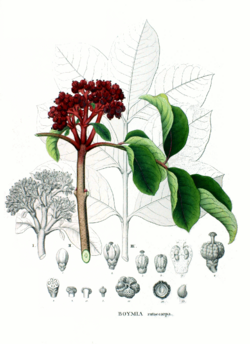Biology:Tetradium ruticarpum
| Tetradium ruticarpum | |
|---|---|

| |
| Scientific classification | |
| Kingdom: | Plantae |
| Clade: | Tracheophytes |
| Clade: | Angiosperms |
| Clade: | Eudicots |
| Clade: | Rosids |
| Order: | Sapindales |
| Family: | Rutaceae |
| Genus: | Tetradium |
| Species: | T. ruticarpum
|
| Binomial name | |
| Tetradium ruticarpum (A.Juss.) T.G.Hartley
| |
| Synonyms[1] | |
| |
| Regional names |
|---|
Tetradium ruticarpum is a tree that comes from China and Korea. It was previously classified in the genus Euodia as Euodia ruticarpa. The fruit is usually used, denoted sometimes as fructus. It has a strong bitter taste, and is used in traditional Chinese medicine (TCM) and is a recognized herb in Kampo. Both the former genus name and the species name are often misspelled, and the plant usually appears in sources dealing with traditional Chinese medicine as "Evodia(e) rutaecarpa".
Production
Cultivation
Tetradium ruticarpum is grown mainly in China.
Harvesting
The fruit is picked. It may be consumed as food.
Traditional medicine
Traditional Chinese medicine
In traditional Chinese medicine the herb is described as a fruit.
Kampo
Tetradium ruticarpum is called 呉茱萸 (Goshuyu) in Japanese, used in Goshuyu-tou and Unkentou (:ja:温経湯). These are Kampo (漢方) preparations of mixed herbs, the former named after this plant.[2] The mixture is noted for having a high concentration (132.6 to 706.3 mmol/100 g) of antioxidants, where the other constituents of the mixture rank lower.[3]
Contraindications
Allergic reactions have occasionally been reported in users of medicinal preparations of the plant.[citation needed]
Biochemical analysis
There has been relatively little scientific study of Tetradium ruticarpum except for antioxidant capacity of one of its mixtures. T. ruticarpum contains Synephrine, Evodiamine (named after the former name of the genus), and indole alkaloids like rutecarpine, a COX-2 inhibitor.
Variants
There are a few variants:[4]
- var. officinalis
- var bodinieri (Dode) Huang
References
- ↑ "Tetradium ruticarpum (A.Juss.) T.G.Hartley". World Checklist of Selected Plant Families (WCSP). Royal Botanic Gardens (Kew). http://www.theplantlist.org/tpl1.1/record/kew-2514718. Retrieved 21 November 2014.
- ↑ http://www.keio-kampo.jp/vc/catalog/formulas/goshuyu-to.html
- ↑ Carlsen, MH; Halvorsen, BL; Holte, K; Bøhn, SK; Dragland, S; Sampson, L; Willey, C; Senoo, H et al. (2010). "The total antioxidant content of more than 3100 foods, beverages, spices, herbs and supplements used worldwide". Nutr J 9: 3. doi:10.1186/1475-2891-9-3. PMID 20096093.
- ↑ https://kampo.ca/herbs-formulas/herbs/goshuyu/
Wikidata ☰ Q10919698 entry

